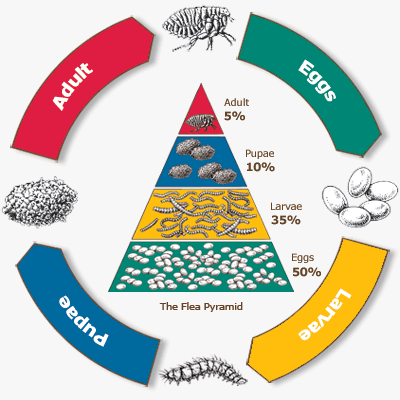A Midsummer's Horror Story

Zombies! Vampires! Our houses are being overrun with these shady characters at an alarming rate. There is a metaphorical horror film being recorded daily on a small scale, but with real consequences for the happiness of our pets, and for our own sanity. You notice Fido scratching or biting out large patches of fur, even damaging his own skin. Mittens is spending more time grooming, and is also starting to show thinning fur and scabby skin. They couldn’t possibly be turning into zombies, could they???
Of course (and thankfully) these supernatural beings are figments of Hollywood’s imagination, but there is still real-life parasite war going on under our feet. You may have guessed that I am talking about FLEAS, one of the many Vampires of the animal world. These bloodsuckers do a fairly good job of making your pet’s life an itchy, scratchy world of pain, and it doesn’t take long for the whole house to become infested. The Central San Joaquin Valley in California is a perfect environment for fleas to multiply, and it doesn’t take long for Fido or Mittens to be inundated by hundreds, if not thousands of fleas.
For every adult flea, there are at least 10 flea eggs in the environment. Yuck!
A Brief Education on the Flea Life Cycle:
 It is important to understand the flea life cycle in order to figure out how to conquer the flea problem you may be having. The adult flea spends its entire life on an animal, with the sole purpose of eating and reproducing. Fleas consume blood meals (just like Vampires!) many times per day, causing itching and redness at the site of the bite. Adult fleas can live longer than two years as long as food is continuously available.
It is important to understand the flea life cycle in order to figure out how to conquer the flea problem you may be having. The adult flea spends its entire life on an animal, with the sole purpose of eating and reproducing. Fleas consume blood meals (just like Vampires!) many times per day, causing itching and redness at the site of the bite. Adult fleas can live longer than two years as long as food is continuously available.
The adult female flea lays thousands of eggs during her life. The eggs do not stay on the animal, but fall off onto the ground (or carpet, or pet bedding), where they hatch into little flea larvae. Flea larvae are like a cross between a vampire and a zombies: they hate light (like vampires) so they crawl around in the depths of the carpet or underneath the bed and into cracks in the floorboards; here they crawl slowly and aimlessly (just like zombies), hoping to find old skin cells or flea poop or other debris to eat. Once the larva matures, it forms a silk cocoon, maturing over 2 weeks, then lying in wait for the vibrations, heat, or carbon dioxide of an unsuspecting host. Mature fleas can wait for many months inside their silk cocoons before a host approaches, at which point they spring out of their hiding place, jumping onto a new animal and starting the cycle over again.
Signs of Flea Infestation:
Fleas crawl all over your dog or cat, from head to toe, but most animals tend to scratch at one specific area—the area just in front of the tail on their back. This area is usually the first to show signs of hair loss and irritation. Seeing this pattern of hair loss almost always indicates flea allergy. You may also notice small pepper-like flakes in your animal’s fur. No, Fido and Mittens haven’t been raiding the spice rack (or maybe they have, knowing my personal pets), but these little black specks are the signs of flea poop, the end result of a day filled with blood meals. Of course there are other types of allergy than can cause similar signs, but none is as easy to treat as flea allergy.
What’s the Antidote for Vampires and Zombies?:
Fortunately, we have some FANTASTIC flea treatments available in the veterinary world. All are aimed at putting a big STOP SIGN in place at some step in the flea life cycle, preventing fleas from continuing to multiply. The treatments are generally either topical drops or oral medications, both of which are super easy to administer, allowing flea protection for 1 or 3 months (depending on product). The nice thing about these products is that they are actually effective, as opposed to the old flea bath/flea collar combination that never did work as advertised. If you’re already using flea protection for Fido and Mittens, GOOD JOB. Your pet is happier and healthier because of it, and your house is a cleaner, safer place for them to live. Remember, it is important to put a stop to all fleas in the environment, so all dogs and cats must be treated to gain true control of the problem.
The second phase of treatment for fleas is household cleaning. Remember all those eggs being dropped onto the carpet? 50% of eggs can be eliminated by frequent vacuuming, helping to prevent the larval stages from doing their zombie-crawl. In addition, there are household parasiticides available that help to control the remaining flea issue, but they usually only have to be used in a severe infestation.
AM I SAFE NOW???:
Yep, year-round flea protection of all household pets is usually all you need to prevent those Zombie and Vampire outbreaks from ever becoming a problem. Which really is quite a feat if you think about it—Hollywood’s been trying to kill the undead since 1922 (first sighting of mainstream Dracula in Nosferatu)…
Article written by Adam Lauppe, DVM
Please feel free to distribute this article (at no charge) via all media— all we ask is that you give credit to the author Dr. Adam Lauppe. You will find him at the best veterinary hospital in Merced, California– Valley Animal Hospital. www.vahmerced.com and www.valleyanimalmerced.com
